Home » Jazz Articles » Live Review » Barry Guy New Orchestra: Krakow, Poland, November 20-23, 2012
Barry Guy New Orchestra: Krakow, Poland, November 20-23, 2012
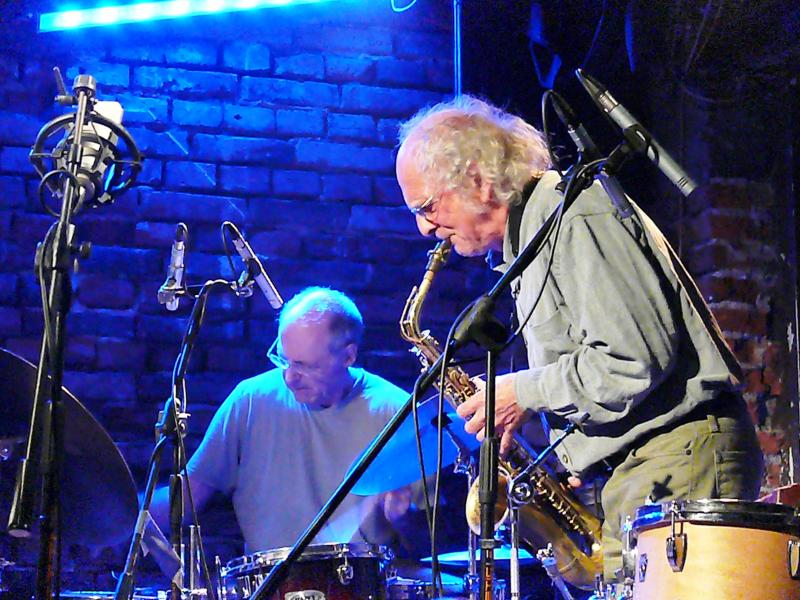
Alchemia
Krakow, Poland
November 20-23, 2012
Now in its seventh year, the annual autumn jazz extravaganza—Krakowska Jesien Jazzowa, in the beautiful Polish city of Krakow—has gone from strength to strength. It's impossible to see all the acts on the bill without spending several months in residence as they come in blocks from early October through to the start of December. Famed in recent years for its vibrant jazz scene, the festival attracts top notch acts from America, and Chicago in particular. On the bill earlier in 2012 were reed titan Peter Brötzmann, in consort with multi-instrumentalist Joe McPhee, Scandinavian supergroup The Thing, the DKV Trio featuring saxophonist Ken Vandermark and drummer Hamid Drake, and drummer Tim Daisy, among a host of other European acts including a solo concert from one of Poland's premier improvisers Mikolaj Trzaska.
Most of the events take place in the famed Alchemia club, nestling in the Kazimierz Jewish quarter of the city. Known as the venue for the Vandermark 5's 12 CD box set of the same name (Not Two, 2005), Alchemia provides an intimate space with clear acoustics in the basement of the café, accommodating an audience of some 100 souls. Proprietor of Not Two records, Marek Winiarski, acts as artistic director for the festival and was on hand to introduce each evening.
While a momentous event, this wasn't the first time that bassist Barry Guy = 7303's New Orchestra had taken up residence in Krakow, as it appeared there previously in November, 2010. Reprising that occasion, the orchestra broke down into small group sessions for the first three nights at Alchemia, while rehearsing during the day for the grand finale, a concert by the BGNO in the well-appointed auditorium of the nearby Manggha Museum on the concluding Friday night.
Guy stands as a singular figure in modern music, personifying an unequalled meeting of the classical, contemporary, jazz and improv worlds. Renowned as a sensitive interpreter of baroque early music (the Englishman appears on over 150 recordings, and has performed with all the specialist early music ensembles), that strand of his oeuvre remains relatively separate, though renditions of the works of seventeenth century composer H.I.F. Biber regularly feature on his recordings with his partner, violinist Maya Homburger, such as the marvelous Tales Of Enchantment (Intakt, 2012), alongside his own compositions. But the two strands for which he is best known are the high voltage improv, showcased to stunning effect in a long standing trio of compatriots saxophonist Evan Parker and drummer Paul Lytton, and the large scale charts of the London Jazz Composers Orchestra, seen in its last incarnation on Harmos Live At Schaffhausen (Intakt, 2012).
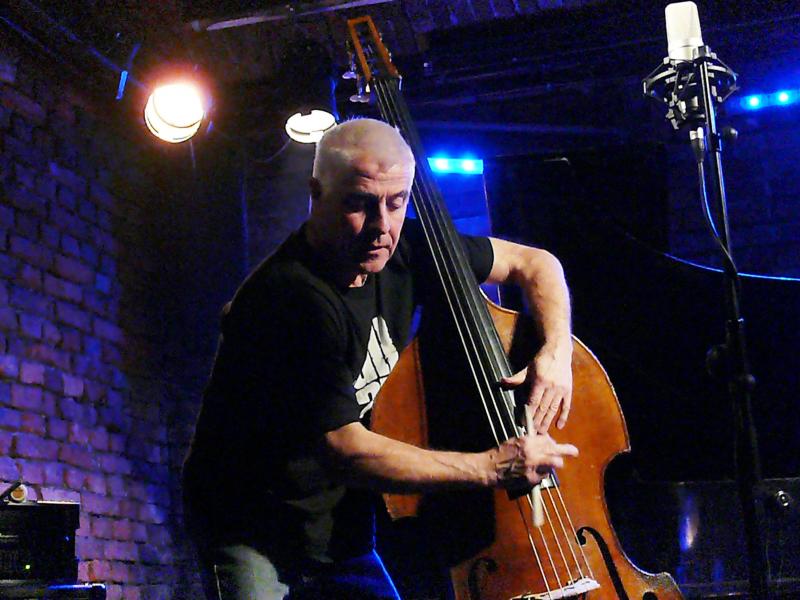
As one of the world's preeminent improvisers on bass, Guy was simply breathtaking to observe. His bursts of hyperactivity combined precise articulation, a plethora of extended approaches and seemingly inexhaustible stamina. While he might wield a mallet with one hand, to mine overtones from the strings both above and below the bridge, with the other he would simultaneously finger rapidly changing notes and chords. Any normal bassist would be content executing one or the other, rather than trying both.
As guitarist George Burt of the Glasgow Improvisers Orchestra comments, in the sleeve notes of its collaboration with the bassist on Schweben—Ay, but can ye? (Maya, 2012), there are several facets which combine to make Guy's orchestral work: the unity of the composed and improvised passages; the concern for the capabilities and strengths of individual players; and the way in which small groups are a part of the larger construct of his major pieces. All of those have been apparent through the development of first the LJCO and now the BGNO. While, at one level there, was a marked contrast between the spontaneous give-and-take of the first three nights and the whole ensemble pieces, at another it was simply a matter of the charts providing a framework within which the subsidiary groupings could intermingle. In Guy's words, the Alchemia sessions offered an opportunity to explore what a big band could be. And what a terrific range there was, veering from hushed exchanges of timbres via incendiary free jazz to out and out noise.
That first evening began with Spanish pianist Agusti Fernandez alone on the stage. For his opening gambit, he swiped at the strings, rasping across the wires, creating impossible glissandos and almost electronic slabs of sound. Over the four days, the Spaniard proved likely to spend as much time under the bonnet as on the keyboard—strumming, rubbing and tapping, but also incorporating his Cecil Taylor-inspired drive with muscular bustling lines, largely eschewing the brooding lyricism of say Aurora (Maya, 2008) and his recent El laberint de la memoria (Mbari, 2011). As he continued, he blended tremolos on the keys with abrasion on the strings for a percussive effect, until exploding solely along the keyboard, heavy on the bass in knotty kernels.
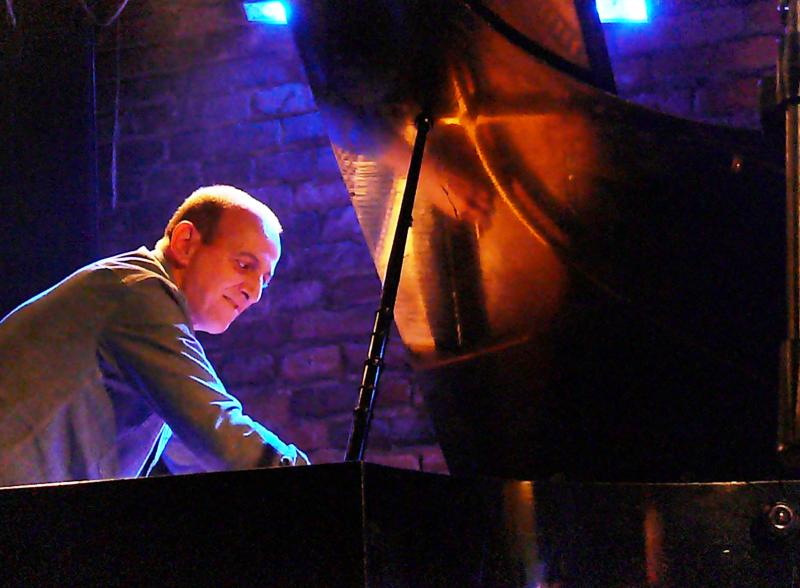
A high whine of indeterminate origin was revealed to emanate from the muted pocket trumpet of Herb Robertson, when he materialized from backstage. Fernandez fell silent leaving the trumpeter to squeeze out the merest of whinnies. His sudden clamorous blasts interrupted the busy litany squeals, slobbers, and blustering squall. As Robertson came to a conclusion, the sound of keypads popping presaged the appearance onstage of Parker. He launched thick intertwined tendrils of circular breathed exhortations on tenor saxophone, tonal fragments which consumed themselves in a tail-chasing round, as both the pianist and trumpeter sat quietly.
Parker reached a crest. Then as he became more pensive, that cued the pair to venture in, gradually initially, but then spinning tales of gathering complexity. Robertson was a master of timbres, aided by an array of mutes spread on a nearby table, but matched Parker for speed of response. Like two galloping thoroughbreds, the pair sped onwards, first one leading then the other, while Fernandez underpinned the madcap dash once more from the innards of his piano. Not without precedent—the trio has recorded Parallelisms (Ruby Flower Records, 2007)—the threesome provided an intriguingly capricious start to the four days.
One of the distinctive features of the BGNO is that it has at its core a number of preexisting combos, such as the enduring Parker/Guy/Lytton outfit and the Tarfala Trio (Guy, with the Swedish duo of drummer Raymond Strid and saxophonist Mats Gustafsson). Unsurprisingly, these established formats carried the greatest weight, with all the orchestra's members skilled at group improvisation, able to conjure art from out of the ether, riposte with such rapidity that it would be impossible to script, and move in unison without anything other than aural clues towards mutually acceptable and fitting conclusions. What was more astounding was the profusion of expression from fun-loving to severe, broad brush to jostling detail, open lattice to sheer cascade. Quality was a given, but even so, some combinations stood out more than others.
One of those was the closing set of the first evening, effectively the Tarfala Trio augmented by trombonist Johannes Bauer and percussionist Lytton in a bravura exhibition. Practiced communication meant that all five always knew where to go, changing direction at the merest hint. Bauer interspersed his emphatic blowsy riffs with breathy squawks and vocal mutters. In this company, Guy avoided elaboration, at times concentrating on a determined high octane strum, as Gustafsson flared in berserk oratory amid Bauer's boozy smears.
Strid and Lytton engendered a feast for the eyes as well as ears with their lively antics, constantly in motion, co-opting and discarding noise-making implements. In the interludes between the impassioned rhetoric, rarely have two drummers made so little noise, as they concentrated on novel textures. In a moment of joyous perfection at the end of the set, Guy bowed low toward the bridge, blending his honeyed sound with the pure tone generated by Strid scraping a stick gently across his cymbal.
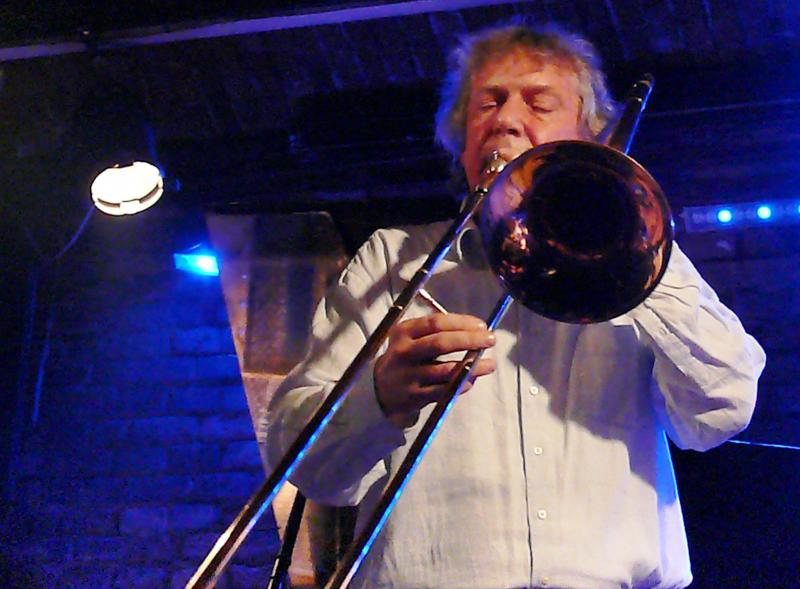
Bauer's unaccompanied set, at the start of the second, evening encapsulated much of what makes him so special. He announced himself with reiterated fanfares, angled from the walls and ceiling and resonating around the room, then constructed his set from these persistent motifs. After the clarion wails he moved onto exhalations, whooshy trills, growls, and chunters, with the trombone only intermittently at his lips. He was even able to incorporate having a sip of red wine into his playful discourse, finishing after further brassy gales by saying "and so on..." with a big smile.
Also of note was Bauer's triumvirate, accompanied by the seasoned Guy/Lytton pairing. Bauer's broad impasto strokes made for a pleasing opposition to the detailed miniatures essayed by bass and drums, both teeming with invention and manic hyperactivity. Guy exhibited an astonishing range. caressing the strings as his fingers slid up and down the neck to finesse the modulated notes—even taking a paintbrush to the strings and body of his bass, exploiting more techniques in five minutes than a lesser player might deploy over a complete evening. Similarities with Lytton were obvious as he cycled through abrasions, scrubs, and clatter—including, in fact, everything including the kitchen sink.
Another threesome, found Parker and Trevor Watts's tenor and alto saxophones respectively merging into a single multi-voiced instrument, while Fernandez stabbed arpeggios, all phrasing in sync. Watts' rich-toned alto resembled a tenor in the depth of his howls, which he effectively contrasted with soaring swoops and choked cries, in one exemplary section. Fernandez provided the substructure, slamming the keys as the horns reached a peak of intertwining combustion. At one point, both Parker and Watts stood side-by-side, circular breathing varying drones embellished with grace notes and phantom voices as the Spaniard sat watching. He then took up a wooden block to rub inside the piano, creating a deep ghostly rumble, which morphed into a haunted harpsichord backdrop. In a densely busy soundscape, both saxophones sparred, cajoled, shadowed and stalked, then negotiated a gentle finish to another excellent set. Even Guy commented on the "lovely ending," in his introduction to the next set.
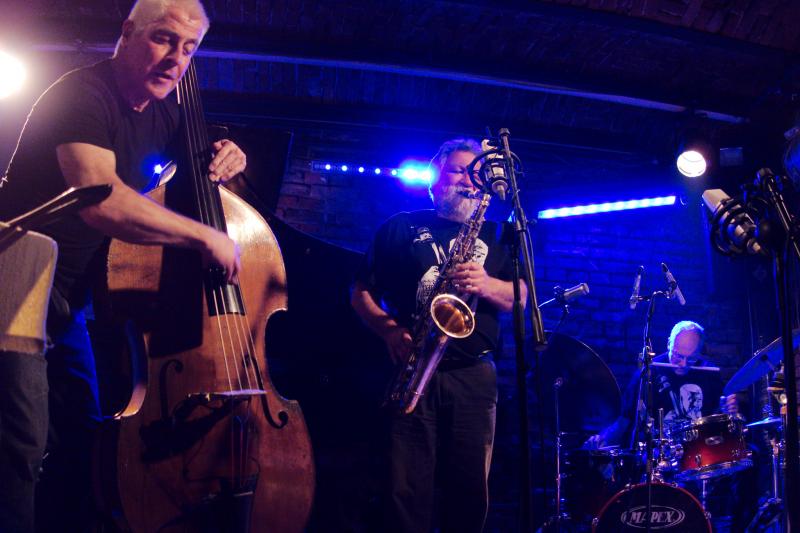
As a complete antithesis, the following trio broadcast only the quietest of pops amid the silence. Ironic as the bottom-heavy firepower assembled onstage comprised Gustafsson's baritone, Per Ake Holmlander's tuba and Hans Koch's bass clarinet. Sporadic proclamations from the two reeds were forged into a coherent narrative, replete with space, and the stop-start momentum. Chortled snuffles suddenly exploded in stentorian bellows. More inspired interplay ensued between Holmlander's snorts, Gustaffson's volcanic outbursts and Koch's heavily vocalized wheezes and chuckles, fashioning a splendid set born of intense concentration.
The concluding grouping of the second evening was the one that everyone had been waiting for—the 32 year-old Parker/Guy /Lytton unit—and they didn't disappoint. To honor the occasion, both Parker and Lytton modeled t-shirts adorned with Guy's image, (the same one visible on the posters advertising the festival emblazoned throughout the city), much to the bassist's horror and the crowd's hilarity.
Homage or not, their set sparkled with a dervish frenzy derived from three intermingling streams of consciousness. Such was the speed of interaction that it was barely possible to keep track. Guy touched on a phrase, Parker instantaneously took it up as a motif to develop and swiftly leave in his wake. Noteworthy details leapt out from the discourse, as at one point the bassist utilized a notched wooden stick as a bow drawing forth koto-like pings. At times like this, trying to convey the magic of the music is a thankless task; this trio has developed its own language. How it sounds is known, but each time is different, like a seascape or cloudscape. Lytton belayed an asynchronous polyrhythmic rattle, while Guy switched between bow and fingers as the moment took him, as all three moved in continuous counterpoint.
At the drummer's request, a duet between Fernandez and Lytton was scheduled, which found the pianist in uncompromising burly debate with the Englishman in invigorating counterintuitive support. But, as if taking delight in as often confounding as confirming colleagues trajectories, the drummer soon started to fragment proceedings with arrhythmic scrapings. Initially, Fernandez carried on regardless, but inexorably the attraction of the percussive textures inside the piano drew him away from the short motifs on the keys which formed the transition. He pounded a thunderous resonance with wooden blocks while Lytton moved onto a variety of shakers and small instruments.
Thereafter, the dynamic alternated between subdued timbral interchange, with Fernandez under the lid, and a headlong flight recalling their opening terrain. At the end, after a passage of lower case tone colors when everyone thought they had finished, Lytton persisted with tiny sounds, enticing Fernandez back into the fray, plucking on the strings with a revolving arm gesture, halfway between relaxing the joints and beckoning everyone on.

What followed was another highlight, as the Tarfala Trio, immortalized on two Intakt CDs and a double LP, Syzygy (No Business, 2011), rounded out the set. The trio which unites Guy, Gustafsson and Strid, embarked on a purposeful journey, relatively restrained in the first instance. Of course that didn't last long. Once Strid kicked off, Guy began to strum manically, raising the tension and Gustafsson delivered his trademark eruptions on baritone saxophone. The prevailing characteristic of their set was the ebb and flow between the explosive bluster and quiet threnody.
Guy initiated the comedown, as the Swede stilled to a meditative drone, before building an amazing solo out of the silvery harmonics he drew from his bass, his hands flying between positions all over the fingerboard, supplemented by a stick at one stage. Strid joined sympathetically, tolling untethered cymbals until Gustafsson intervened with paint-stripping acerbity to ensure it didn't all get too pretty. The trio's tempestuous vitality was manifest in the saxophonist's constant movement, hopping from foot to foot and swaying back and forth. Red-faced, eyes clenched shut, as if attempting self-exorcism, he poured out a litany of staccato plosives and riffing propulsion. Together the players formed a hard-driving trio nonetheless capable of moments of dazzling beauty. Strid's hammer shot on his snare signaled a sudden end to a superb exposition.
For Alchemia's final set, a brass trio incrementally expanded until the entire New Orchestra amassed on the confined bandstand. An avant-oompah feel held sway in a beginning, characterized by humor, receptiveness and a keen sense of the absurd. Holmlander and Bauer traded contrapuntal blows while Robertson (on trumpet) spluttered and buzzed from left field. When Bauer incorporated his vocal shtick, Robertson quickly leapt forward with his own argumentative voice, before once more bringing the trumpet back to his lips, in a syntax part speech and part brass. Ever the maverick, the trumpeter also produced a tiny hunting horn through which he shooshed and swooned along with his brassy co-conspirators.
As the rest of the group gradually squeezed onto the stage, the intensity ratcheted up into the crimson. Watts blew high and hard on alto before Koch cooled the fevered brows with his bass clarinet until he was left with only Fernandez and Guy in tender repose. A series of anthemic swells lead once more to a cathartic blow out, with assorted horns rising up out of the mass, and Gustafsson riffing hard to add some structure to the fray. As exciting as it was, this seemed unfamiliar territory for the band, without the extensive experience of something like Peter Brötzmann's Chicago Tentet at negotiating a path which encouraged space for unexpected combinations and unpredictable ways between them, even though Bauer, Holmlander and Gustafsson feature in both line ups. Somehow the encore, after building to a tumultuous peak, dissolved into a raucous swing. Parker standing right at the back of the stage introduced the theme from pianist Thelonious Monk's "Shuffleboil" on his tenor saxophone (the only composition heard during the first three nights!) but no one was inclined to pick it up, so he sustained the tune alone, allowing it to function as an underlying motif.

For the grand finale on the Friday evening, the Orchestra decamped to the 300-seat auditorium of the Manggha Museum just over the Wisla river. Although the majority of the program consisted of composed works, the opening installment by Parker and Fernandez, celebrated the release of a duet The Voice Is One (Not Two, 2012), recorded live in Barcelona in 2009. True to the disc's title, the pair spoke as one. Fernandez' hands swept up and down the keyboard, stabbing with pointed fingers and hammering in the bass extremities, drawing a sympathetic rejoinder from Parker's brawny yet cerebral tenor saxophone.
At one juncture, the Spaniard manipulated the strings with one hand as his other parlayed a continuous rippling in the middle register, while Parker unfurled an unbroken sequence of circular breathed gobbets. Fernandez, fluent in the same way as the Englishman in compressing swarms of notes into convoluted gnarly branches, jabbed tremolos, crashed the heels of his hand, and pawed along the keys in repeated glissandi. Parker was really pushed and responded in kind in a tour de force exchange, until finally his sustained ascending phrases, heralded the ending of an outstanding first course.
Eventually the BGNO took to the stage. Guy stood at the front, back to the audience ready to conduct the band, seated behind their music stands. Guy introduced the first piece, "Amphi," as a chamber work featuring Maya Homburger's baroque violin in various sub-groupings of the band, and that's exactly how it sounded. Homburger led off, and brought in Robertson, Bauer, Strid and Watts for the first of a series of overlapping sections, which progressed both with and without her violin. The nearest comparator was some of Guy's contemporary music for himself and Homburger, such as Ceremony (ECM, 1999).
Rarely did the full Orchestra play together. A greater variance with the small group sessions at Alchemia was hard to imagine than this piece, which was very austere and corralled the passionate intimate group interaction into a coolly abstract setting, which felt like it needed repeated listenings to fully appreciate. At one point, Robertson nonetheless provided a link to the jazz tradition, his excitable exclamations on muted trumpet evoking Bubber Miley with pianist Duke Ellington's Orchestra. The piece ended literally on a high note, with Homburger bowing at the furthest extreme in tandem with Lytton extracting similar bat bothering sounds from a scraped cymbal.

Two pieces comprised the second half of the performance. The first, Parker's "Vosteen II," featured fellow Englishman Watts on alto saxophone. After a soft-droning hors d'oeuvre from Holmlander, Watts emerged from the colloquy, pitching his insistent fiery narrative against Koch's split tones on bass clarinet. Like a forlorn soul wandering in a hostile wilderness of bristling horns, Watts' overblown alto carried the heft of a tenor in a restless uneasy meditation. Next up was the leader's "Radio Rondo," previously documented by the London Jazz Composers Orchestra with Swiss pianist Irene Schweizer as the featured soloist, on the eponymous 2010 Intakt album, but here reconfigured for the slightly reduced circumstances, with Fernandez in the leading role. Behind the title lay the idea that the guys in the band had been traveling around the world since the last concert and their music had been circulating on the airwaves. That concept informed a tremendous opening collective which erupted from nothing, as if a radio was turned on to find the band in mid expression. Thereafter, a series of quick fire smaller groupings surfaced between orchestral blasts, making yet another distinction by way of volume and participation, this time with the austerity of the first BGNO piece. A melodic section was followed by a joyous duet for muted trumpet and trombone, inaugurating a series of syncopated phrases from paired horns which fizzed around the stage.
Guy alternated between conduction and adding bass parts, even playing with one hand on the fingerboard and the other directing crescendos. At one point, Fernandez stepped out from behind the piano to take on conduction duties as Guy hit a heavy groove, bowing darkly under the massing orchestra. At the end, the bassist sawed high and the orchestra repeatedly threatened to percolate up to a terminal roar but then, with pummeling drums and piano, Guy unleashed them for the ultimate all-out assault until his arm came down and they stopped on a dime, as if an off switch had been turned. It was a superlative conclusion not only to the evening but to the whole marvelous four days. A barrage of applause from the enraptured audience ensured that after the curtain calls and the presentation of flowers, Guy and Parker returned for a brief mercurial duet, wonderful in its fleetness and responsiveness.

Word on the street is that discussions are underway to schedule a similar residency for the BGNO in London at Café Oto, in 2014. That would be something to look forward to. Meanwhile, ambitious plans are also afoot for the next Krakow Jazz Autumn. Director Marek Winiarski is looking at similar extended stays for Ken Vandermark's Resonance Ensemble, investigating the possibility of a large project led by Mats Gustafsson, and Japanese pianist Satoko Fujii's European Orchestra. If even one—let alone all—of these possibilities come off, then jazz fans will be flocking to Krakow next fall.
Photo Credit
Guy/Parker/Lytton and Tarfala Trio Photos: Andy Newcombe
All Other Photos: John Sharpe
< Previous
Jorge Luis Pacheco: Where In The Worl...
Next >
Introducing Shingo Yuji
Comments
Tags
barry guy
Live Reviews
John Sharpe
Poland
Krakow
Peter Brotzmann
Joe McPhee
The Thing
Ken Vandermark
Hamid Drake
Tim Daisy
Mikolaj Trzaska
Vandermark 5
evan parker
Paul Lytton
Agusti Fernandez
Cecil Taylor
Herb Robertson
Raymond Strid
Mats Gustafsson
Johannes Bauer
Trevor Watts
Thelonious Monk
Bubber Miley
duke ellington
Satoko Fuji
For the Love of Jazz
 All About Jazz has been a pillar of jazz since 1995, championing it as an art form and, more importantly, supporting the musicians who create it. Our enduring commitment has made "AAJ" one of the most culturally important websites of its kind, read by hundreds of thousands of fans, musicians and industry figures every month.
All About Jazz has been a pillar of jazz since 1995, championing it as an art form and, more importantly, supporting the musicians who create it. Our enduring commitment has made "AAJ" one of the most culturally important websites of its kind, read by hundreds of thousands of fans, musicians and industry figures every month.
























